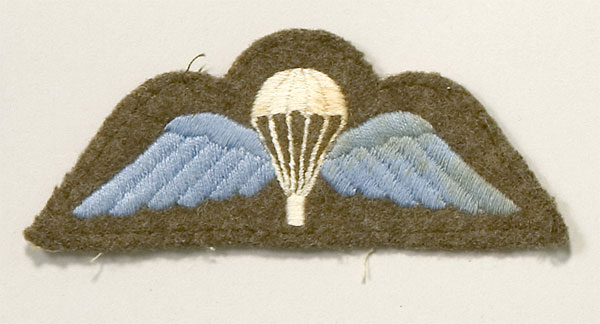Military Patch
c 1940
British Army Cloth Shoulder Parachute Badge (patch) for regular parachute troops.
The British Airborne insignia was worn with great pride on the paratrooper’s beret or upper sleeve. The British Airborne troops, as elite soldiers, were trained in special combat skills. They constituted a valuable branch of General Eisenhower’s forces in Western Europe.
On June 6, 1944, troops from the British 6th Airborne Division, commanded by Major General Richard Gale, were assigned to protect the Allied invasion’s east flank. Landing by glider and parachute in the pre-dawn hours, they took the enemy by surprise and succeeded in taking their D-Day objectives.
British glider troops of the Oxfordshire and Buckinghamshire Light Infantry, under Major John Howard, had an especially dangerous mission. They were to capture the bridges over the Caen Canal and Orne River. This they did within ten minutes of landing. They held the crossings against vicious counter-attacks until other British troops came inland from the beach to relieve them. By taking these two vital bridges in the early stages of D-Day, the Ox and Bucks prevented enemy reinforcements from attacking the invasion from the east, a major worry for General Eisenhower.
In September 1944 the British 1st Airborne Division and the Polish Parachute Brigade jumped into enemy occupied Holland during Operation MARKET-GARDEN. Their mission was to capture the bridge over the Rhine River at Arnhem. Things did not go well for the Allies, as the Germans had more soldiers and tanks present than anticipated, and prevented the Brits and Poles from taking the bridge. The 1st Airborne Division alone lost 7,800 men killed, wounded, missing, or captured out of the original 10,000 who had either parachuted or come in by glider. It was a disaster.
The invasion plans for Holland had been devised by Field Marshal Montgomery. Monty, as he was sometimes called, was an advocate of advancing against Germany on a narrow front. For the British Airborne, sent 64 miles behind enemy lines, the bridge at Arnhem was “a bridge too far.” After this major set back, Eisenhower never again put much stock in Montgomery’s “narrow front” view. From then on the General was a very strong proponent of advancing on a broad front.
Cloth. L 9.5, W 3.8 cm
Eisenhower National Historic Site, EISE 15735



